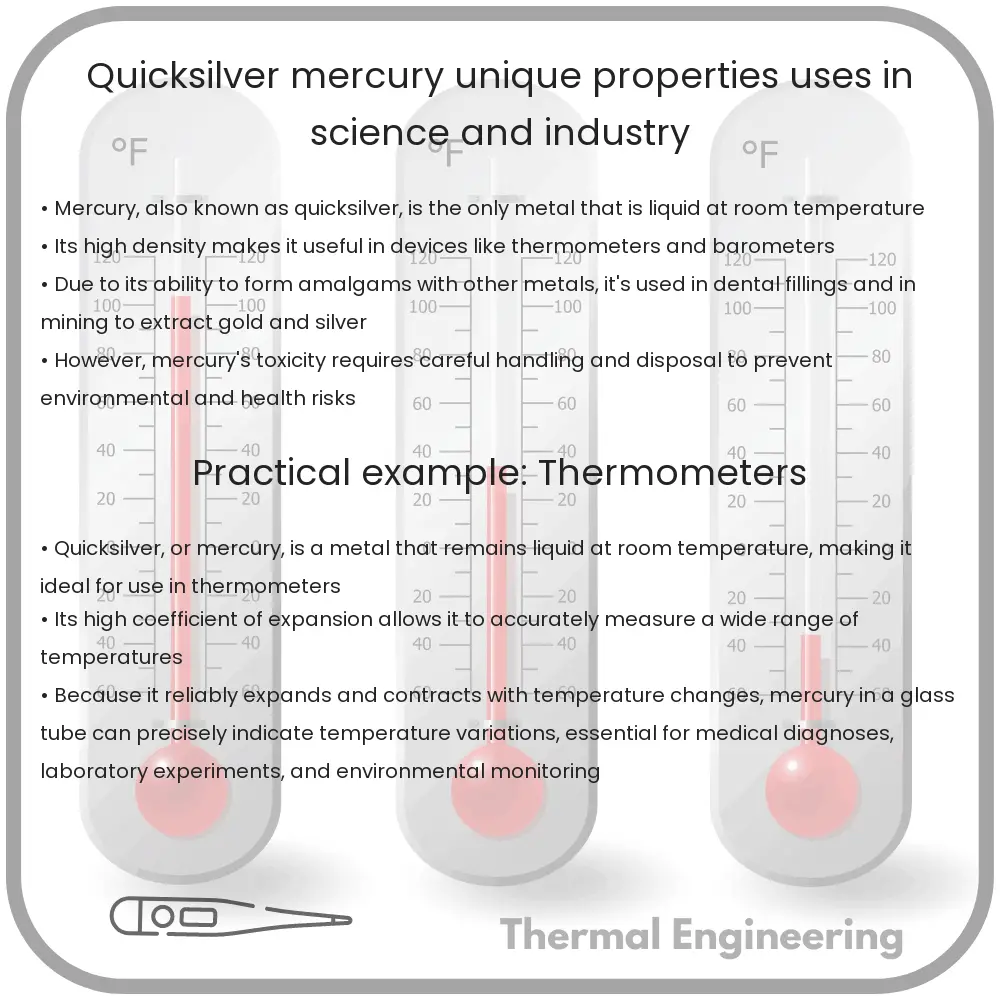Exploring Mercury’s unique properties, uses in science and industry, and its environmental and health impacts.

Quicksilver (Mercury): Unique Properties, Uses in Science and Industry
Mercury, often known by its historic name ‘quicksilver,’ is a remarkable element that has fascinated humanity for centuries. Its chemical symbol, Hg, is derived from the Greek word hydrargyrum, meaning “liquid silver. Mercury is the only metal that is liquid at standard room temperature and pressure, which accounts for many of its unique properties and diverse applications in science and industry.
Unique Properties of Mercury
Mercury distinguishes itself with several unique physical and chemical properties:
- Liquid Metal: Its melting point is -38.83°C, which allows it to remain liquid at room temperature.
- Density: Mercury is incredibly dense, about 13.6 times more so than water, making it useful in devices where weight and compactness are crucial.
- Conductivity: As a metal, mercury is a good conductor of electricity, which makes it suitable for various electrical applications.
- Thermal Expansion: Mercury exhibits a nearly uniform thermal expansion, beneficial in the precise measurement of temperature in thermometers.
Uses of Mercury in Science
Mercury’s properties make it valuable in multiple scientific applications:
- Thermometers: The uniform thermal expansion of mercury allows it to provide precise temperature readings in thermometers.
- Barometers: Mercury is used in barometers to measure atmospheric pressure due to its high density and minimal vapor pressure.
- Sphygmomanometers: In medicine, mercury sphygmomanometers are used to measure blood pressure accurately.
However, due to mercury’s toxicity, many of these applications are being replaced by safer alternatives.
Uses of Mercury in Industry
Mercury also finds several critical uses in various industries:
- Chlor-alkali Process: In the chemical industry, mercury is utilized in the chlor-alkali process to produce chlorine and sodium hydroxide. This process involves the electrolysis of saltwater where mercury acts as a cathode.
- Dentistry: Dental amalgams, used for fillings, contain mercury mixed with other metals, which provides a strong, resilient bonding material.
- Electrical and Electronics: Due to its conductivity, mercury is used in switches and rectifiers. It was historically used in batteries as well.
- Preservative: Mercury compounds act as preservatives and antibacterials in many cosmetic products and some vaccines.
Environmental and Health Concerns
Although mercury has many useful applications, it poses significant health and environmental risks. Mercury exposure can lead to serious health issues, including neurological damage and kidney disease. Consequently, efforts are being made to reduce the use of mercury and to find safer alternatives in industrial, scientific, and medical equipment
Moreover, environmental concerns arise due to bioaccumulation of mercury in water bodies, affecting aquatic life and entering the human food chain through fish and other seafood. International conventions like the Minamata Convention aim to decrease and eventually eliminate mercury usage and emissions globally.
Conclusion
Mercury’s fascinating properties make it indispensable in various scientific and industrial applications. Nonetheless, the risks associated with its use are prompting a gradual shift towards safer alternatives. Understanding both the benefits and hazards of mercury is essential for developing responsible science and technology policies.